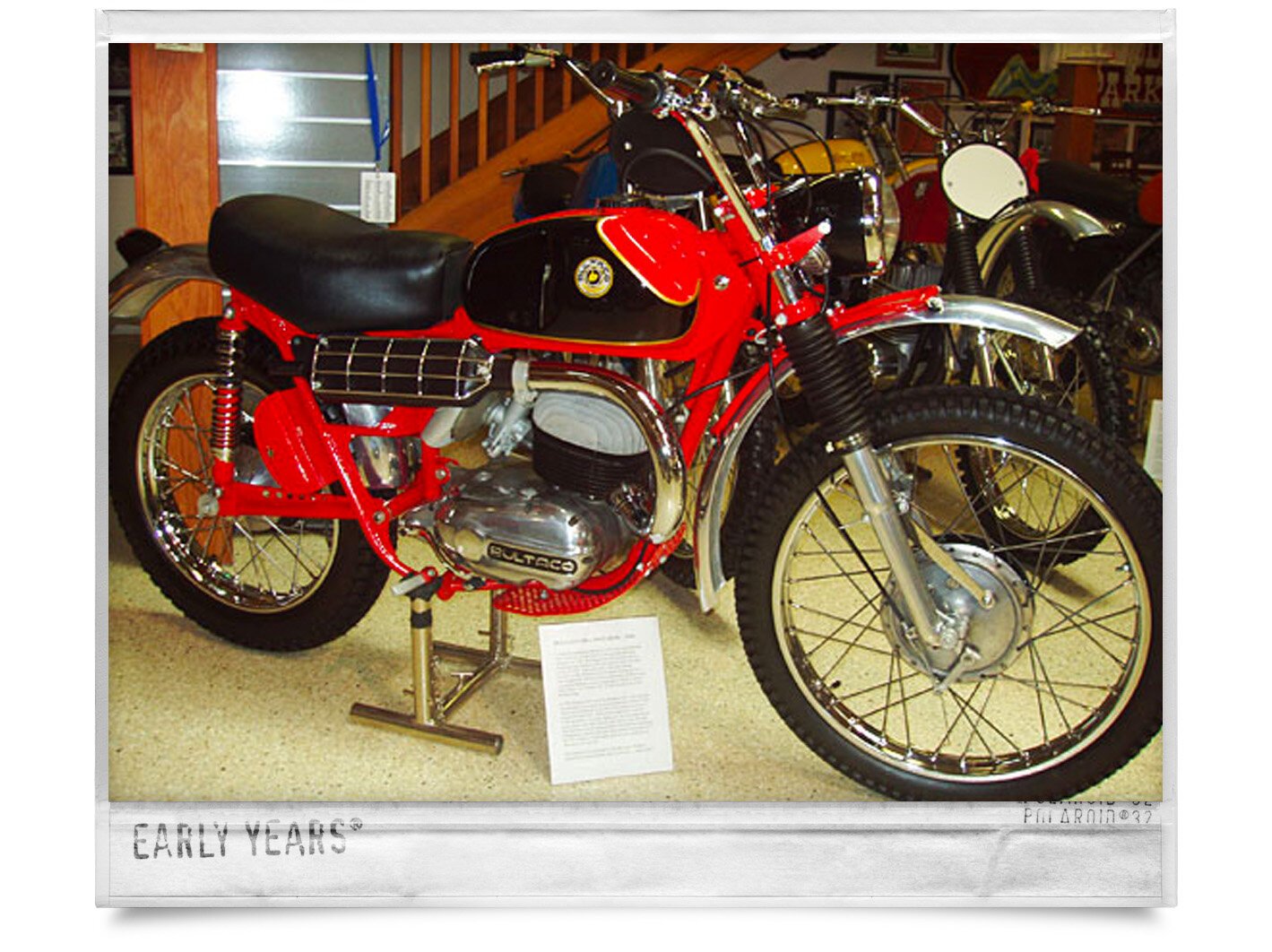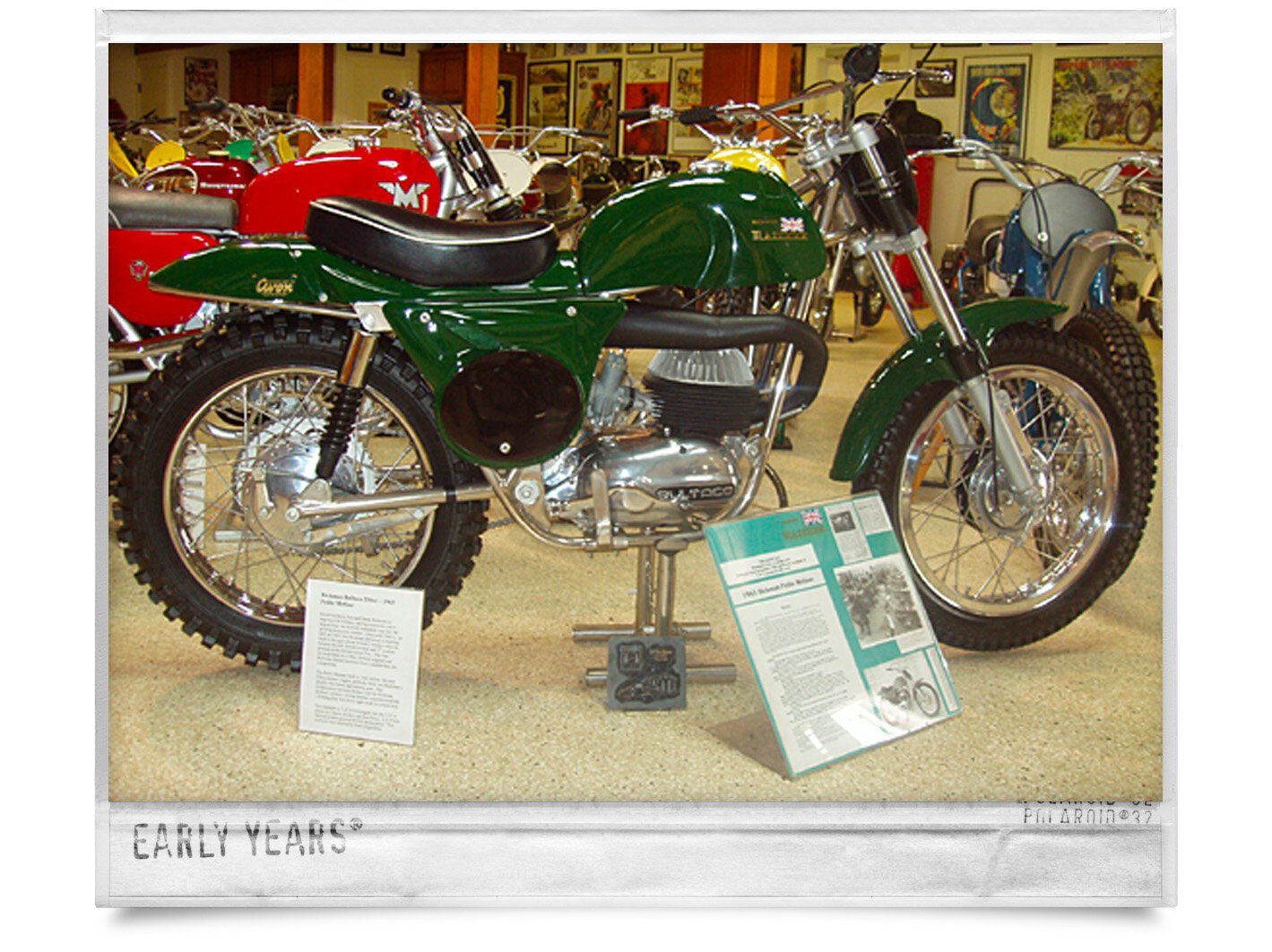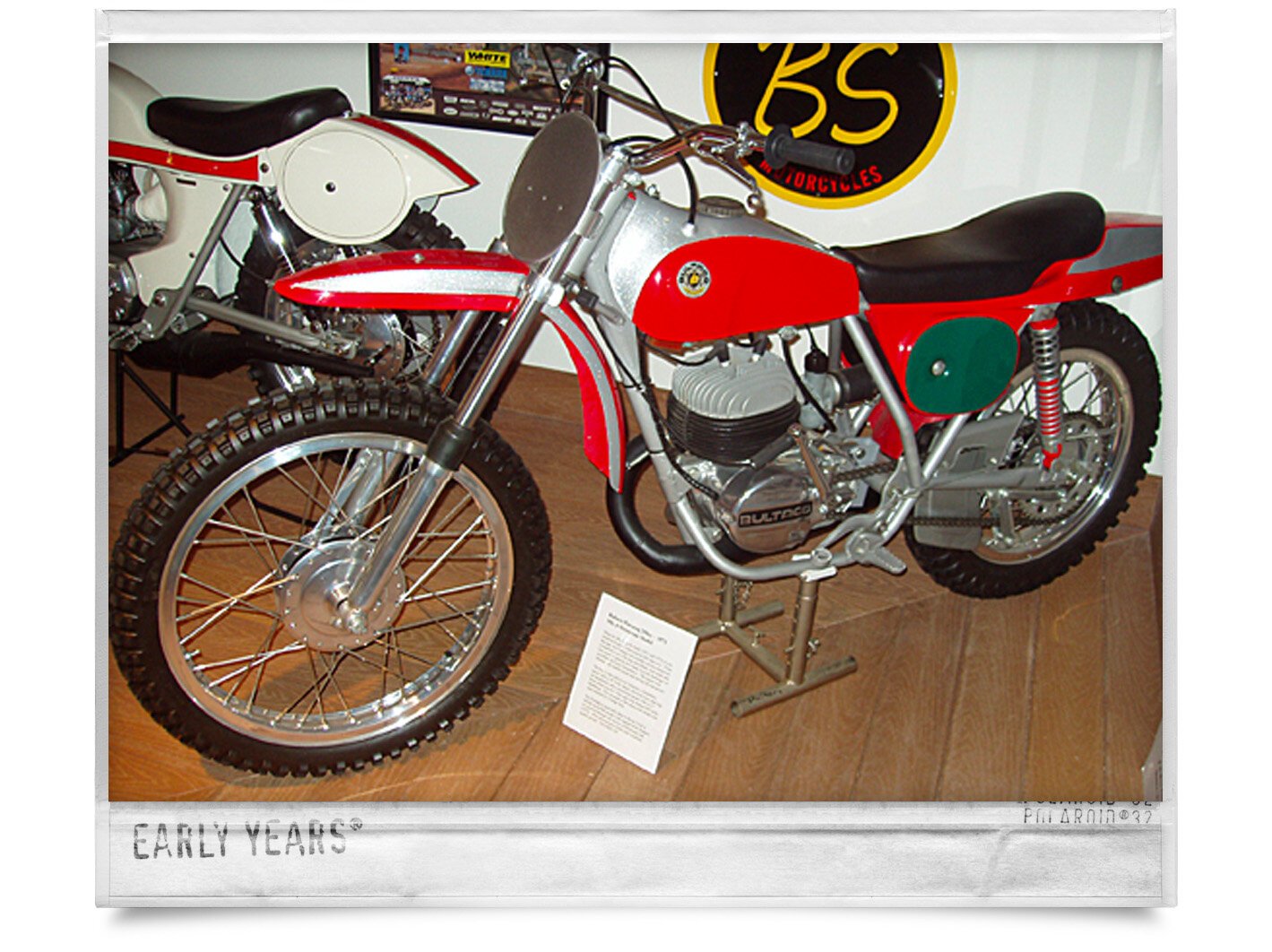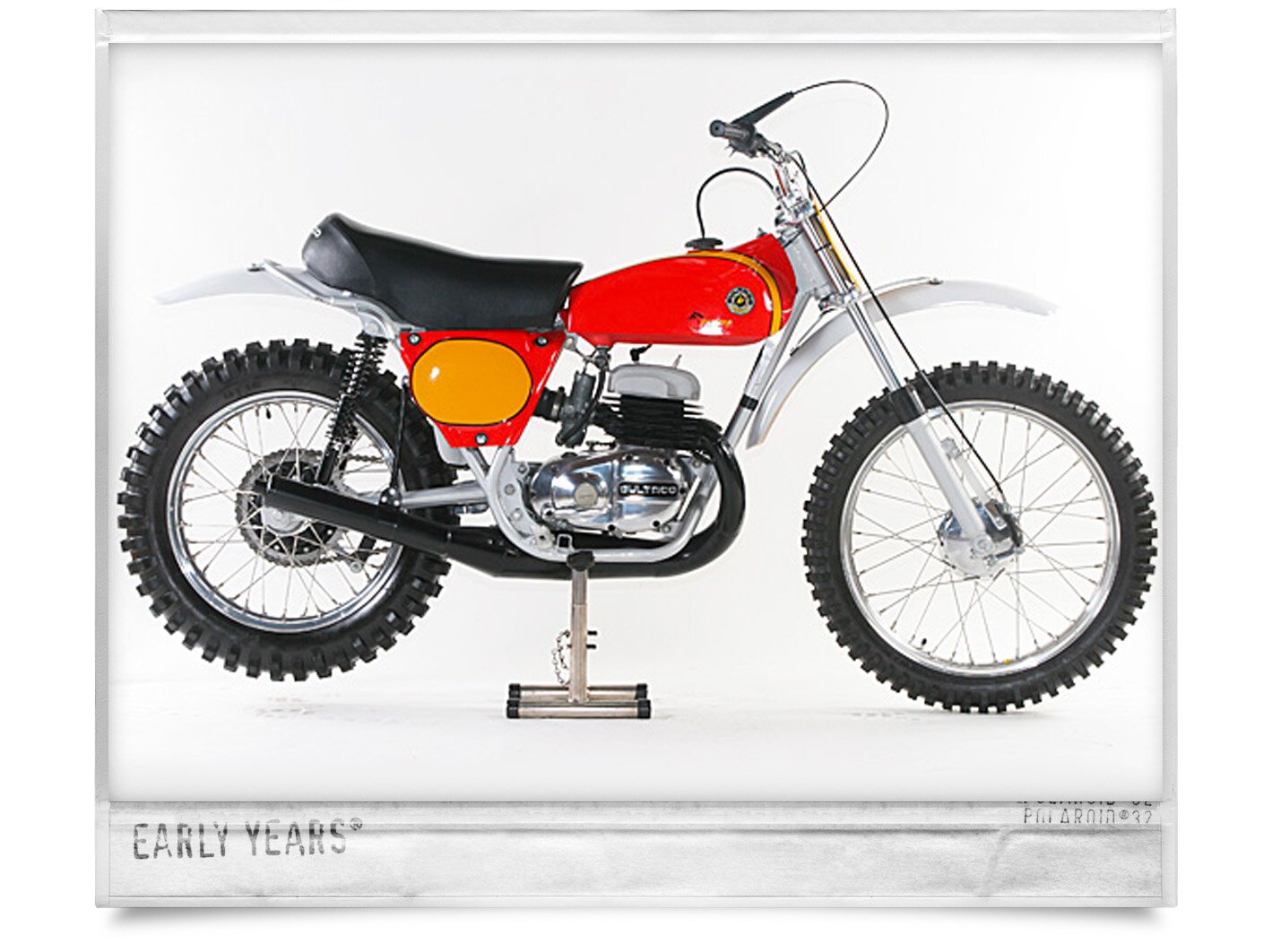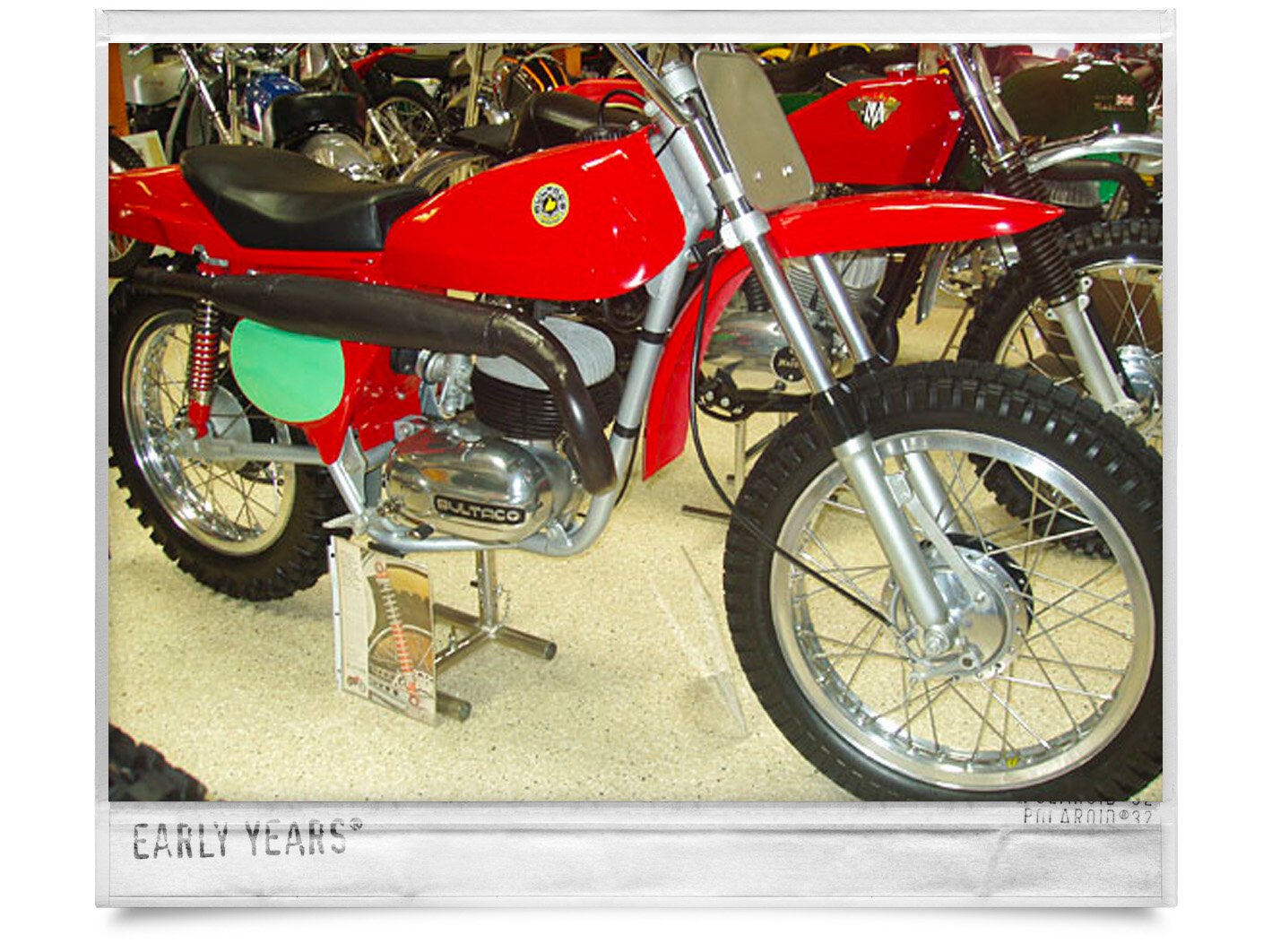BULTACO 200cc MATADOR / 1964
A Spanish roadracing champion both before and after the war, Francisco Xavier Bulto co-founded the Montesa company in 1946. He resigned his directorship after a board meeting voting to retire the factory from GP road racing in 1958. That same year, with other former members of the Montesa firm, he began tooling up for a new motorcycle which was announced early the following year as the Bultaco, a name suggested by Bulto’s friend – John Grace. A “Thumbs Up” would become part of the Bultaco logo.
In 1964 Bultaco introduced the Matador 200. The machine was designed to compete in the International 6-Days Trials which was considered to be one of the toughest tests of a motorcycle and rider. With a full compliment of street legal equipment – ie, horn, lights, etc. the bike appealed to many street riders that liked to ride both on and off-road. The machine used the premier Betor rebuildable suspension components, Akront rims, and had a peak horsepower of 23 hp. The Matador would open up an all new market for a dual-sport motorcycle.
This machine was restored by Bob Benson, a Bultaco expert from Massachusetts and is quite rare. Please enjoy!
RICKMAN BULTACO 250cc / Petite Metisse / 1965
British brothers, Don and Derek Rickman as importers for Bultaco, and top motocross riders helped forge the Spanish companies way into the growing motocross market – circa early 1960’s. As early as 1963, Don Rickman delivered a crippling blow to the agricultural British 2-strokes when he became the only British finisher and 3rd podium position at the British Grand Prix. This was accomplished on a 196cc Bultaco engined and Rickman framed machine 50cc’s smaller than the competition.
The Petite Metisse, built in 1965 utilizes the new 250cc Bultaco engine, perfectly fitted into Rickman’s jewelry like frame and running gear. The collaboration between Bultaco and the Rickman brothers yielded a similar Bultaco manufactured Mk 1 Pursang that was down right crude in comparison.
This example is 1 of 24 bootlegged into the U.S. in pieces by Charlie Hockie and Bud Ekins. U.S. Petite Metisse’s were painted British racing green. This example was restored by Matt Hilgenberg.
BULTACO PURSANG 250 MK4 MOTOCROSS MODEL / 1971
When the Mk. 4 hit the track (1971 and 1972) it was hailed as Bultaco’s best looking dirt bike ever. From the start, the Pursang was a deadly serious motocross competitor even if its long wheelbase, fork angle and low center of gravity also made it a true challenger in smoother dirt track competition. The engine was blessed with usable torque and strong top end power.
The Mk. 4 was sold in two versions, a scrambles model with a 19” front wheel, universal tires, and clip on handlebars, and a motocross model with a 21” front wheel, knobby tires, and cross braced MX style handlebar. This example is the motocross model and was restored by Vintage Iron.
The Pursang is especially dear to me as I rode a similar scrambles model with support from Bultaco in America through my novice professional year (1972). What an awesome slider with excellent usable power! THUMBS UP!
BULTACO 360 PURSANG MKVII / 1974
Bultaco had been a very successful brand in American scrambles racing since the mid 1960’s and enjoyed some success in motocross on a local level, but seldom on the national or international level. That would change when American upstart Jim Pomeroy shocked the FIM international motocross establishment by winning the 1973 250cc Spanish motocross Grand Prix. The news of his victory created a huge wave of excitement in America where motocross was undergoing an explosive growth in popularity. His victory signaled that American motocross riders were ready to compete with the best in the world and so was Bultaco.
Bultaco, founded in 1958 by Francisco Xavier Bulto, first introduced an open class machine in 1967 as the 350cc El Bandido. Early models were plagued with excessive weight and power that few riders could tame. By 1974 the 360cc Pursang was nearly identical in design to the production 250 that Pomeroy had ridden to win the Spanish Grand Prix. Claimed horsepower was 39 at 7000rpm……which in print favored well with other open class machines, but in reality, seemed like “A load of bull!” That was mitigated by the way the Pursang hooked up! Open class Bultaco riders felt like nothing cornered like a Bultaco and you could steer thru the turns with the throttle wide open. The lower than most seating position also favored riders under 6′ tall.
The 360 Pursang was a beautiful machine! It is often mentioned how the Spanish factory had dirt floors. That being said, the Pursang was an absolutely jewel! The engine cases were highly polished as were the fork crowns and the hubs. The fenders, side panels, airbox, and fuel tank were fiberglass with a very nice painted finish. Other niceties included Femsa ignition, Betor front and rear suspension, and Akront shoulderless rims with Pirelli tires.
BULTACO PURSAND MK2 250cc SCRAMBLER / 1967
The MKII Pursang would be a major change from the Rickman inspired MKI Pursang and only the engine would remain similar. The wheelbase was extended over 1 _” and the body work was distinctively square leading to many riders calling the Pursang the “Boat-tail” for its similarity to a sailing ship. Both a motocross model (21” front wheel) and a scrambles model (19” front wheel) were available in America.
For motocross, it could easily be argued that Bultaco went the wrong direction as the increased power was rather peaky and the longer wheelbase made quick changes of directions difficult. Fortunately, this proved to be just what scramble riders in America wanted for the higher speed and smoother tracks. Out of the crate, the MKII put out 34 horsepower, a good 5 horsepower more than many of its European competitors. The fiberglass body work was absolutely beautiful, but unfortunately was easily damaged the first time the rider would fall down. The high pipe also over-heated the rider’s right leg and bottom and would give way the next year to a low pipe.
Amazing that such a beautiful machine was made in a Spanish factory with dirt floors.
Restored by Bob Benson the machine is now owned by the The Early Years of Motocross Museum.
BULTACO EL BANDITO 360 / 1968
The Spanish Bultaco El Bandido first appeared in 1967 as 350cc model and in 1968 the bore was increase from 83.2mm to 85mm which gave it 362cc and 43.5hp. Therein lays the problem! Weighing in at 251lbs, some 20 pounds heavier than the 250 Pursang and with almost 10 more horsepower, very few riders were capable of taming the Bandit!
Spanish metal was often blamed for the poor reliability of the Spanish brands – Bultaco, Ossa, and Montesa and the problem was only accentuated with the big bore El Bandido. The machine also used a Femsatronic electric ignition that would prove to be unreliable.
As with the 250cc Pursang models, the Bandido was available in both motocross and scrambles models. In America, far more scrambles models would be sold as the longish wheelbase (55.9”), 31 degree head angle, and ample power was better suited to smoother scrambles tracks.
Though they are largely ignored by AHRMA racers they have become a very desirable collector bike. Because there were relatively few sold in America, nice original machines command a high price. Let’s not forgot how beautiful the El Bandido is when restored to like new condition. This handsome example was restored by Steve Morris.
BULTACO EL BANDITO 360 / 1968
The Spanish Bultaco El Bandido first appeared in 1967 as 350cc model and in 1968 the bore was increase from 83.2mm to 85mm which gave it 362cc and 43.5hp. Therein lays the problem! Weighing in at 251lbs, some 20 pounds heavier than the 250 Pursang and with almost 10 more horsepower, very few riders were capable of taming the Bandit!
Spanish metal was often blamed for the poor reliability of the Spanish brands – Bultaco, Ossa, and Montesa and the problem was only accentuated with the big bore El Bandido. The machine also used a Femsatronic electric ignition that would prove to be unreliable.
As with the 250cc Pursang models, the Bandido was available in both motocross and scrambles models. In America, far more scrambles models would be sold as the longish wheelbase (55.9”), 31 degree head angle, and ample power was better suited to smoother scrambles tracks.
Though they are largely ignored by AHRMA racers they have become a very desirable collector bike. Because there were relatively few sold in America, nice original machines command a high price. Let’s not forgot how beautiful the El Bandido is when restored to like new condition. This handsome example was restored by Steve Morris.

